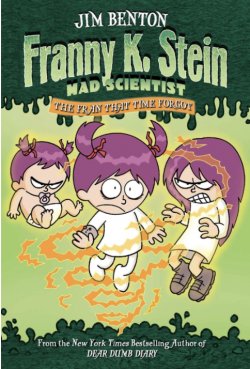Gareth B. Matthews

Review of Franny K. Stein: Mad Scientist – The Fran That Time Forgot by Jim Benton (New York: Simon & Schuster, 2005). Originally published in Thinking: The Journal of Philosophy for Children 17(4): 3.
Franny K. Stein is both a little girl and also a mad scientist. She created a special kind of dog food with zero gravity to make walking her dog easier and more fun. She invented cannibalistic broccoli so that kids who hate vegetables would never have to eat them.
Franny has a regular mom, a regular dad, and a regular little brother. But she herself is anything but a regular little girl. No other member of her family is even interested in science. She is mad about it.
When Franny hears of the science fair that is to be held at her school this year she has mixed feelings. She loves creating new things to show them off to other kids. But she already has a long list of things she wants to invent. And she doesn’t want to interrupt her inventing schedule. “You can’t have your cake and eat it, too,” her mother tells her. “Oh. Can’t I?” Franny thinks to herself; “I’ll see about that.”
Franny invents a “time-warp” dessert plate. Using this plate Franny can eat her cake and then make a small zone on the plate to go back to the time just before she had eaten the cake.
At the school science fair Franny wins first prize for her time-warp dessert plate. But the certificate she receives gives her full name, ‘Franny Kissypie Stein.’ rather than just her name with the middle initial, “K,’ which she prefers. All the school kids laugh when they hear that first prize goes to Franny Kissypie Stein. Franny is humiliated. Then she becomes infuriated.
Franny resolves to extend her time-warp invention so that she herself can go back to the time when she was a newborn baby to change her middle name. Confronting her baby self in the hospital nursery, she goes to the chart on the crib and erases her middle name except for the initial ‘K.’ But what middle name should she give herself in place of ‘Kissypie?’ She settles on ‘Kaboom.’
On her way back to the present time, Franny decides to keep on going past the present into the future. The teenage Franny she meets in her own future frightens her. Moreover, she finds the inventions of teenage Franny downright repulsive, and the person she is to become, evil.
When Franny returns to the science fair, she discovers that the other kids are if anything, even more amused by ‘Kaboom’ than they were by ‘Kissypie.’ But before she flies into another rage it dawns on Franny that she didn’t have to change her name in the first place. What she had to change was how she felt about people laughing at her name. Moreover, she now resolves not to turn into the evil teenager Franny she had seen on her journey into her future.
Some philosophers think that the idea of time travel is logically incoherent. After all, for Franny to go back to the time of her birth she has to become, in a way, two people: the time traveler alongside the baby she visits. But surely one person cannot become two.
The greatest logician of the 20th Century, Kurt Godel, dismissed this objection. Obviously thinking that the idea of time travel is coherent, Godel went so far as to offer a formula for calculating the amount of energy that would be required to go back a little or a very long period of time. As l once heard the late Elizabeth Anscombe put the matter.
Godel’s formula makes it clear that a wealthy government would be able to send someone a very long way back into the past, but even the wealthiest government would not be able to afford the cost of sending someone back to yesterday.
Jim Benton, the author of this ‘Franny K. Stein’ story (it is one of a series), uses the idea of time travel as a sort of thought experiment. Suppose you could go back in time and change your middle name, or do something else that, you might now think, would make your present life better. Or suppose that you could travel into your future to see what you will become, given the direction in which your life is now headed. How might altering your past or seeing into your future affect your present plans and attitudes?
In this story Franny learns from her travel into the past that she can achieve the result she wants, not by altering something done long ago, but rather by changing her present attitude towards what happened then. She also learns by anticipating what her present self is likely to turn into, what she needs to do now to become the person she really wants to become later on.
This story is fast-paced, outrageously zany, and genuinely funny. But, despite the inventiveness and sheer fun on every page, it is also a morally serious story. Best of all, it manages to be morally serious without ever becoming moralistic. That feat is almost as mind-boggling as time travel.
